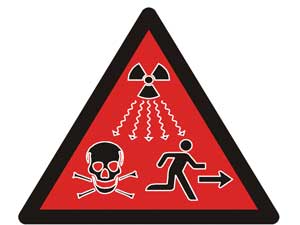|
NEWS NOTES — NEWS
Science and society
IAEA updates radiation warning symbol
 |
| The International Atomic Energy Agency has created a new symbol for radiation. The trefoil, or the propeller-looking symbol at the top of the new symbol, once stood alone for radiation, but studies suggested that too few people recognized it as a warning. Image is courtesy of IAEA. |
On Feb. 15, the International Atomic Energy Agency (IAEA) unveiled its new design of the international symbol for radiation. Dozens of accidental exposures to radiation motivated this change. In 1987, for example, four people in Brazil died when they dismantled an abandoned cancer treatment machine, and in 2001, four men fell ill after they disassembled generators at a Russian nuclear-powered lighthouse.
“Too many people are injured each year by finding large sources of radiation and not understanding what the trefoil — the international symbol for radiation — means,” says Carolyn Mac Kenzie, a radiation source specialist with IAEA. “Many people are either injured or killed in these events.”
Initiated in 2001, the project was intended to supplement the familiar radiation symbol, the yellow-on-black three-cornered trefoil, which was designed to be simple and conspicuous to prevent it from getting lost among the plethora of easily ignored warnings. But IAEA discovered that simplicity presented problems. Children all over the world consistently identified the radiation hazard symbol as a propeller.
The new triangular sign features the trefoil with radiating waves, a skull and crossbones, and a running man against a bright red background. Graphic designers and radiation experts spent five years refining the symbol to give a clear warning to anyone who might stumble across a radioactive device. The Gallup Institute tested the new design on 1,650 people in 11 countries to confirm that all population groups, regardless of age, sex or level of education, knew immediately that the symbol conveyed danger. The symbol is intended to be universal, and to especially protect individuals whose cultural backgrounds have not prepared them to fear the trefoil, or even radioactivity, Mac Kenzie says.
IAEA intends to place the symbol on all new small radioactive sources, such as food irradiators and cancer treatment machines. The sign will not be plainly visible on the outside of these machines to avoid alarming people in everyday settings; instead, it will be apparent inside the machines if dismantled.
The new radioactive symbol is not slated for use on nuclear waste drums or nuclear waste storage sites, such as the proposed Yucca Mountain nuclear waste storage facility in Nevada and the Waste Isolation Pilot Plant (WIPP) in New Mexico that houses military radioactive waste. For these long-term storage facilities, researchers with the U.S. Department of Energy have been working with archaeologists, linguists and astronomers, among other varied experts, on a symbol that might suggest danger 10,000 years from now — not an easy task. Like the new IAEA symbol, the overarching goal is to come up with a symbol that would convey danger to people who could not read nor understand common languages. “It is probable that [the new radiation symbol] would be incorporated” into that design, says Roger Nelson, chief scientist at WIPP.
Considerations for long-term symbols, however, played no part in the design of the new IAEA symbol, Mac Kenzie says. Though she says that she hopes that the symbol’s message will remain self-evident far into the future, she says, “it is anyone’s guess as to what would be understood at that point.”

 Subscribe
Subscribe


